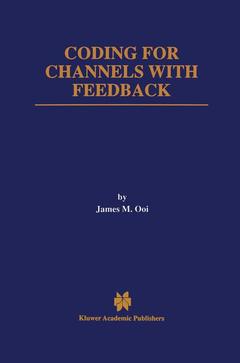Coding for Channels with Feedback, Softcover reprint of the original 1st ed. 1998 The Springer International Series in Engineering and Computer Science Series, Vol. 452
Langue : Anglais
Auteur : Ooi James M.

Coding for Channels with Feedback presents both algorithms for feedback coding and performance analyses of these algorithms, including analyses of perhaps the most important performance criterion: computational complexity. The algorithms are developed within a single framework, termed the compressed-error-cancellation framework, where data are sent via a sequence of messages: the first message contains the original data; each subsequent message contains a source-coded description of the channel distortions introduced on the message preceding it.
Coding for Channels with Feedback provides an easily understood and flexible framework for deriving low-complexity, practical solutions to a wide variety of feedback communication problems. It is shown that the compressed-error-cancellation framework leads to coding schemes with the lowest possible asymptotic order of growth of computations and can be applied to discrete memoryless channels, finite state channels, channels with memory, unknown channels, and multiple-access channels, all with complete noiseless feedback, as well as to channels with partial and noisy feedback. This framework leads to coding strategies that have linear complexity and are capacity achieving, and illustrates the intimate connection between source coding theory and channel coding theory.
Coding for Channels with Feedback is an excellent reference for researchers and communication engineers in the field of information theory, and can be used for advanced courses on the topic.
Coding for Channels with Feedback provides an easily understood and flexible framework for deriving low-complexity, practical solutions to a wide variety of feedback communication problems. It is shown that the compressed-error-cancellation framework leads to coding schemes with the lowest possible asymptotic order of growth of computations and can be applied to discrete memoryless channels, finite state channels, channels with memory, unknown channels, and multiple-access channels, all with complete noiseless feedback, as well as to channels with partial and noisy feedback. This framework leads to coding strategies that have linear complexity and are capacity achieving, and illustrates the intimate connection between source coding theory and channel coding theory.
Coding for Channels with Feedback is an excellent reference for researchers and communication engineers in the field of information theory, and can be used for advanced courses on the topic.
1 Introduction.- 1.1 Feedback in Communication.- 1.2 Overview.- References.- 2 DMCs: An Introduction to the Framework.- 2.1 Introduction.- 2.2 Variable-Length Codes and Their Properties: Rate, Reliability, and Complexity.- 2.3 A Feedback Coding Scheme for DMCf’s.- 2.4 Reliability.- 2.5 Removing the Perfect-Detection Assumption.- 2.6 Complexity.- 2.7 Variations.- 2.8 Discussion.- Appendix to Chapter 2.- 2.A Proof of Subsystem Property 1.- 2.B Proof of Subsystem Property 2.- 2.C Proof of Subsystem Property 3.- 2.D Proof of Lemma 2.4.1.- 2.E Proof of Lemma 2.4.2.- 2.F Proof of Subsystem Property 4.- 2.G Modified Scheme Reliability.- 2.H Precoding with Linear Complexity.- 2.I Fixed-Length Precoding and Source Coding Subsystems.- 2.J Analysis of Variable-Length Interleaving.- References.- 3 Channels with Memory.- 3.1 Introduction.- 3.2 Generalization of the Coding Scheme.- 3.3 A Coding Scheme for DFSCf’s.- 3.4 Complexity.- 3.5 Discussion.- Appendix to Chapter 3.- 3.A Ergodic Finite-Order Markov Input to Indecomposable DFSCf’s.- 3.B Efficiency Property of the Precoder.- 3.C Interaction between Precoder and Source Coder.- 3.D A Fast Algorithm for Conditional Shannon-Fano Source Coding.- 3.E Synchronization-Sequence Detection.- 3.F Lemmas Relating to Entropy Rates.- References.- 4 Unknown Channels.- 4.1 Introduction.- 4.2 Formulation of Variable-Length Coding for Unknown Channels.- 4.3 A Universal Communication Scheme for a Class of UFSC’s.- 4.4 Complexity.- 4.5 Uniform Convergence.- 4.6 Discussion.- Appendix to Chapter 4.- 4.A Properties of the Conditional Lempel-Ziv Coder.- 4.B Universal Detection of the Synchronization Sequence.- References.- 5 Multiple-Access Channels.- 5.1 Introduction.- 5.2 Formulation of Variable-Length Coding for Two-User Multiple-AccessChannels.- 5.3 Low-Complexity Coding Scheme for Two-User Multiple-Access Channels.- 5.4 Performance Analysis.- 5.5 Discussion.- Appendix to Chapter 5.- 5.A Fixed-Length Source Coder for Tx-2.- References.- 6 Channels with Partial and Noisy Feedback.- 6.1 Introduction.- 6.2 Feedback Rate Reduction.- 6.3 A Concatenated Coding Framework for Combining FEC Codes with Feedback Codes.- 6.4 Feedback Coding on the Erasure Channel and ARQ.- 6.5 Coping with Noisy Feedback.- 6.6 Discussion.- References.- 7 Conclusions.
Date de parution : 10-2012
Ouvrage de 174 p.
15.5x23.5 cm
Thèmes de Coding for Channels with Feedback :
© 2024 LAVOISIER S.A.S.



